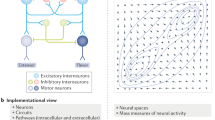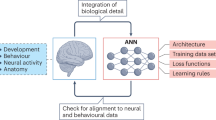Abstract
Although integration is a widely acknowledged goal in neuroscience, our approach to the function of biological entities often places boundaries that defy integration. Mapping across systems — from the genome to cognitive function — will require innovative methods that can identify every contributing component to a function, and instantaneously scale numerous changes in large data sets to consequences over the entire biological hierarchy.
This is a preview of subscription content, access via your institution
Access options
Subscribe to this journal
Receive 12 print issues and online access
$189.00 per year
only $15.75 per issue
Buy this article
- Purchase on Springer Link
- Instant access to full article PDF
Prices may be subject to local taxes which are calculated during checkout
Similar content being viewed by others
References
Mohr, J. P. Some clinical aspects of acute stroke. Stroke 28, 1835–1839 (1997).
Reich, D. S., Mechler, F. & Victor, J. D. Independent and redundant information in nearby cortical neurons. Science 294, 2566–2568 (2001).
Poeppel, D. A critical review of PET studies of phonological processing. Brain Lang. 55, 317–351 (1996).
Fox, P. T. & Raichle, M. E. Focal physiological uncoupling of cerebral blood flow and oxidative metabolism during somatosensory stimulation in human subjects. Proc. Natl Acad. Sci. USA 83, 1140–1144 (1986).
Fox, P. T., Raichle, M. E., Mintun, M. A. & Dence, C. Nonoxidative glucose consumption during focal physiologic neural activity. Science 241, 462–464 (1988).
Logothetis, N. K., Pauls, J., Augath, M., Trinath, T. & Oeltermann, A. Neurophysiological investigation of the basis of the fMRI signal. Nature 412, 150–157 (2001).
Dhond, R. P., Buckner, R. L., Dale, A. M., Marinkovic, K. & Halgren, E. Spatiotemporal maps of brain activity underlying word generation and their modification during repetition priming. J. Neurosci. 21, 3564–3571 (2001).
Horwitz, B. & Poeppel, D. How can EEG/MEG and fMRI/PET data be combined? Hum. Brain Mapp. 17, 1–3 (2002).
Haxby, J. V. et al. Distributed and overlapping representations of faces and objects in ventral temporal cortex. Science 293, 2425–2430 (2001).
Tanaka, K. Inferotemporal cortex and object vision. Annu. Rev. Neurosci. 19, 109–139 (1996).
Logothetis, N. K. & Sheinberg, D. L. Visual object recognition. Annu. Rev. Neurosci. 19, 577–621 (1996).
Kanwisher, N., McDermott, J. & Chun, M. M. The fusiform face area: a module in human extrastriate cortex specialized for face perception. J. Neurosci. 17, 4302–4311 (1997).
Gauthier, I., Skudlarski, P., Gore, J. C. & Anderson, A. W. Expertise for cars and birds recruits brain areas involved in face recognition. Nature Neurosci. 3, 191–197 (2000).
Dixon, M. J., Bub, D. N. & Arguin, M. Semantic and visual determinants of face recognition in a prosopagnosic patient. J. Cogn. Neurosci. 10, 362–376 (1998). | PubMed
Warrington, E. K. & Shallice, T. Category specific semantic impairments. Brain 107, 829–854 (1984).
Coslett, H. B., Saffran, E. M. & Schwoebel, J. Knowledge of the human body: a distinct semantic domain. Neurology 59, 357–363 (2002).
Cohen, L. G. et al. Functional relevance of cross-modal plasticity in blind humans. Nature 389, 180–183 (1997).
Finney, E. M., Fine, I. & Dobkins, K. R. Visual stimuli activate auditory cortex in the deaf. Nature Neurosci. 4, 1171–1173 (2001).
Sur, M. & Leamey, C. A. Development and plasticity of cortical areas and networks. Nature Rev. Neurosci. 2, 251–262 (2001).
Mellet, E., Petit, L., Mazoyer, B., Denis, M. & Tzourio, N. Reopening the mental imagery debate: lessons from functional anatomy. Neuroimage 8, 129–139 (1998).
Churchland, P. S. & Churchland, P. M. Neural worlds and real worlds. Nature Rev. Neurosci. 3, 903–907 (2002).
Hoffman, E. A. & Haxby, J. V. Distinct representations of eye gaze and identity in the distributed human neural system for face perception. Nature Neurosci. 3, 80–84 (2000).
Martin, S. J., Grimwood, P. D. & Morris, R. G. Synaptic plasticity and memory: an evaluation of the hypothesis. Annu. Rev. Neurosci. 23, 649–711 (2000).
Roskies, A. L. The binding problem. Neuron 24, 7–9 (1999).
Rubenstein, J. L., Martinez, S., Shimamura, K. & Puelles, L. The embryonic vertebrate forebrain: the prosomeric model. Science 266, 578–580 (1994).
Bulfone, A. et al. An olfactory sensory map develops in the absence of normal projection neurons or GABAergic interneurons. Neuron 21, 1273–1282 (1998).
Held, L. I. Pattern as a function of cell number and cell size on the second-leg basitarsus of Drosophila. Wilhelm Roux's Arch. 187, 105–127 (1979).
Eurich, C. W. & Schwegler, H. Coarse coding: calculation of the resolution achieved by a population of large receptive field neurons. Biol. Cybern. 76, 357–363 (1997).
Godfrey-Smith, P. On the theoretical role of 'genetic coding'. Philos. Sci. 67, 26–44 (2000).
Tang, Y. P. et al. Genetic enhancement of learning and memory in mice. Nature 401, 63–69 (1999).
Silva, A. J., Paylor, R., Wehner, J. M. & Tonegawa, S. Impaired spatial learning in α-calcium-calmodulin kinase II mutant mice. Science 257, 206–211 (1992).
Grant, S. G. N. et al. Impaired long-term potentiation, spatial learning, and hippocampal development in fyn mutant mice. Science 258, 1903–1910 (1992).
Abel, T. et al. Genetic demonstration of a role for PKA in the late phase of LTP and in hippocampus-based long-term memory. Cell 88, 615–626 (1997).
Futatsugi, A. et al. Facilitation of NMDAR-independent LTP and spatial learning in mutant mice lacking ryanodine receptor type 3. Neuron 24, 701–713 (1999).
Mansuy, I. M., Mayford, M., Jacob, B., Kandel, E. R. & Bach, M. E. Restricted and regulated overexpression reveals calcineurin as a key component in the transition from short-term to long-term memory. Cell 92, 39–49 (1998).
Garcia, J. A. et al. Impaired cued and contextual memory in NPAS2-deficient mice. Science 288, 2226–2230 (2000).
Uetani, N. et al. Impaired learning with enhanced hippocampal long-term potentiation in PTPδ-deficient mice. EMBO J. 19, 2775–2785 (2000).
Madani, R. et al. Enhanced hippocampal long-term potentiation and learning by increased neuronal expression of tissue-type plasminogen activator in transgenic mice. EMBO J. 18, 3007–3012 (1999).
Katafuchi, T., Li, A. J., Hirota, S., Kitamura, Y. & Hori, T. Impairment of spatial learning and hippocampal synaptic potentiation in c-kit mutant rats. Learn. Mem. 7, 383–392 (2000).
Motro, B., Wojtowicz, J. M., Bernstein, A. & van der Kooy, D. Steel mutant mice are deficient in hippocampal learning but not long-term potentiation. Proc. Natl Acad. Sci. USA 93, 1808–1813 (1996).
Donahue, C. P. et al. Transcriptional profiling reveals regulated genes in the hippocampus during memory formation. Hippocampus 12, 821–833 (2002).
Gass, P. et al. Deficits in memory tasks of mice with CREB mutations depend on gene dosage. Learn. Mem. 5, 274–288 (1998).
Maniatis, T. & Reed, R. An extensive network of coupling among gene expression machines. Nature 416, 499–506 (2002).
Parks, C. L., Robinson, P. S., Sibille, E., Shenk, T. & Toth, M. Increased anxiety of mice lacking the serotonin 1A receptor. Proc. Natl Acad. Sci. USA 95, 10734–10739 (1998).
Brown, J. R., Ye, H., Bronson, R. T., Dikkes, P. & Greenberg, M. E. A defect in nurturing in mice lacking the immediate early gene fosB. Cell 86, 297–309 (1996).
Lai, C. S., Fisher, S. E., Hurst, J. A., Vargha-Khadem, F. & Monaco, A. P. A forkhead-domain gene is mutated in a severe speech and language disorder. Nature 413, 519–523 (2001).
Blackshaw, S., Fraioli, R. E., Furukawa, T. & Cepko, C. L. Comprehensive analysis of photoreceptor gene expression and the identification of candidate retinal disease genes. Cell 107, 579–589 (2001).
Rosen, H. J., Lengenfelder, J. & Miller, B. Frontotemporal dementia. Neurol. Clin. 18, 979–992 (2000).
Bugiani, O. et al. Frontotemporal dementia and corticobasal degeneration in a family with a P301S mutation in tau. J. Neuropathol. Exp. Neurol. 58, 667–677 (1999).
Toma, D. P., White, K. P., Hirsch, J. & Greenspan, R. J. Identification of genes involved in Drosophila melanogaster geotaxis, a complex behavioral trait. Nature Genet. 31, 349–353 (2002).
Young, L. J., Nilsen, R., Waymire, K. G., MacGregor, G. R. & Insel, T. R. Increased affiliative response to vasopressin in mice expressing the V1a receptor from a monogamous vole. Nature 400, 766–768 (1999).
Macagno, E. R., Lopresti, V. & Levinthal, C. Structure and development of neuronal connections in isogenic organisms: variations and similarities in the optic system of Daphnia magna. Proc. Natl Acad. Sci. USA 70, 57–61 (1973).
Goodman, C. S. Isogenic grasshoppers: genetic variability in the morphology of identified neurons. J. Comp. Neurol. 182, 681–705 (1978).
Acknowledgements
I thank R. Jensen, R. Sperling and particularly A. Roskies for their critical reading of the manuscript and their help in shaping my ideas.
Author information
Authors and Affiliations
Related links
Related links
DATABASES
LocusLink
OMIM
FURTHER INFORMATION
Encyclopedia of Life Sciences
Rights and permissions
About this article
Cite this article
Kosik, K. Beyond phrenology, at last. Nat Rev Neurosci 4, 234–239 (2003). https://doi.org/10.1038/nrn1053
Issue Date:
DOI: https://doi.org/10.1038/nrn1053
This article is cited by
-
General methodological considerations for the assessment of nutritional influences on human cognitive functions
European Journal of Nutrition (2005)
-
The relevance of behavioural measures for functional-imaging studies of cognition
Nature Reviews Neuroscience (2004)



